Rice cookers are a popular kitchen appliance that many households use to prepare delicious and fluffy rice. But what about storing rice in a rice cooker? How long can rice stay in a rice cooker before it goes bad?
These are common concerns and questions that many people have when it comes to rice storage in a rice cooker. In this article, we will explore the factors that affect rice storage duration in a rice cooker, how to properly store rice, and the importance of food safety.
Key Takeaways:
- Proper storage practices are crucial for maintaining rice freshness and food safety.
- The optimal duration for keeping rice in a rice cooker depends on various factors such as rice type, temperature, and humidity.
- Extending the rice storage duration in a rice cooker is possible with safe storage techniques.
Preserving Rice in a Rice Cooker
Preserving rice in a rice cooker is an essential aspect of ensuring food safety and maintaining rice quality.
The presence of moisture, warmth, and air inside the rice cooker can promote bacterial growth and spoil the rice, rendering it unsafe for consumption. Therefore, it is crucial to keep the rice cooker clean and free from contaminants before storing the rice.
To preserve the rice, make sure to use a clean spoon or spatula when transferring the rice from the rice cooker to another container. Avoid using your hands or dirty utensils, as this can transfer bacteria to the rice and cause contamination. It is also recommended to store the rice in an airtight container to prevent moisture and air from entering.
It is important to maintain the rice cooker at a temperature below 40 degrees Fahrenheit to prevent bacterial growth. The rice should not be stored in the rice cooker for more than two hours after cooking, as the warm environment can promote bacterial growth. However, keeping the rice in the rice cooker’s “keep warm” mode can extend its shelf life for up to 12 hours.
To maximize the shelf life of the rice, store it in the refrigerator or freezer within two hours of cooking. When reheating the rice, make sure to heat it to at least 165 degrees Fahrenheit to kill any bacteria that may have grown during storage.
By following these guidelines, you can ensure that the rice stored in a rice cooker is safe for consumption and that its quality is preserved.
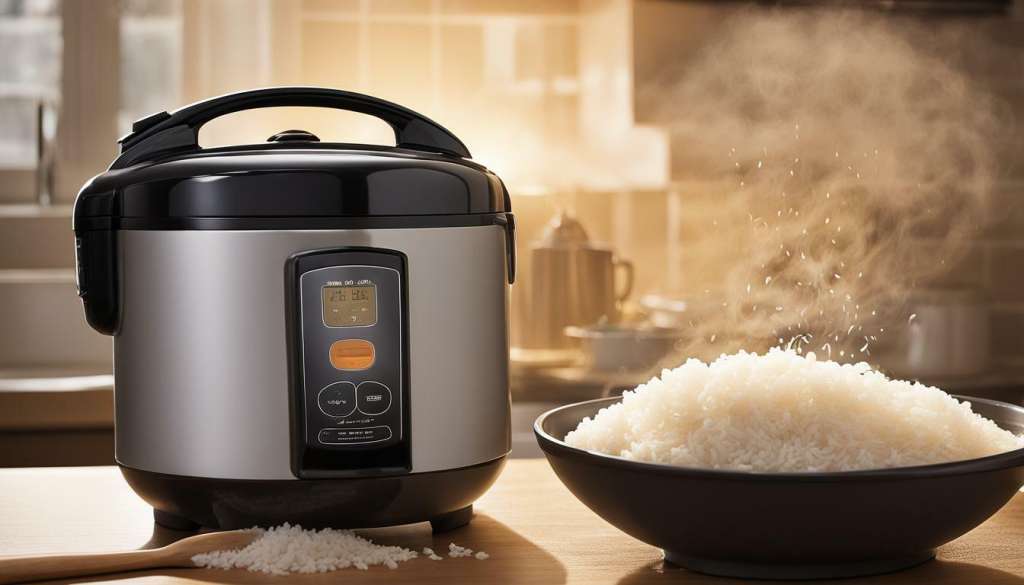
Preserving Rice in a Rice Cooker: Top Tips
- Use a clean spoon or spatula to transfer the rice from the rice cooker to another container.
- Store the rice in an airtight container to prevent moisture and air from entering.
- Maintain the rice cooker at a temperature below 40 degrees Fahrenheit.
- Avoid storing rice in the rice cooker for more than two hours after cooking.
- Use the “keep warm” mode to extend the rice’s shelf life for up to 12 hours.
By following these tips, you can preserve the freshness and quality of your rice stored in a rice cooker.
Maximum Duration for Rice in a Rice Cooker
Knowing the ideal time to keep rice in a rice cooker is crucial to maintaining its quality and safety. The maximum duration for rice in a rice cooker depends on various factors, such as rice type, temperature, and humidity.
For white rice, the maximum duration should be around four to six hours. Brown rice, on the other hand, can be stored for up to eight hours. It is important to note that these guidelines are for cooked rice that has already been processed in the rice cooker. Therefore, it is recommended to transfer the rice to a different container if you plan on storing it for extended periods.
The storage duration of rice can also be affected by the environment where the rice cooker is placed. If the temperature and humidity levels are high, the storage time can be reduced. On the other hand, keeping the rice cooker in a cool and dry place can help extend the storage time.
Ultimately, the ideal time to keep rice in a rice cooker depends on a case-by-case basis. As a general rule, it is advisable to keep the rice in the rice cooker for no more than six hours to maintain its quality and safety.
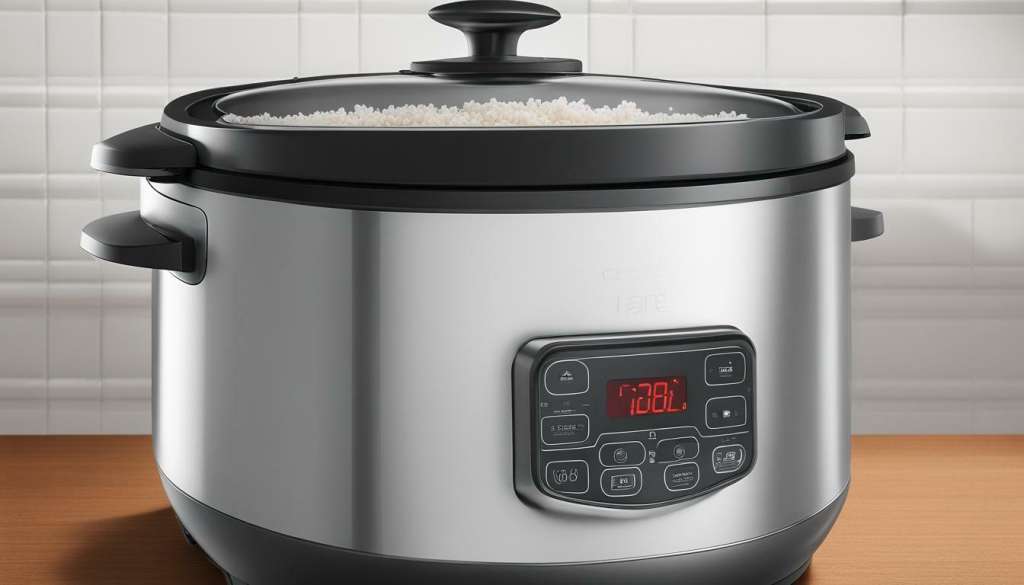
Tips to Keep in Mind
- Always check for signs of spoilage, such as strange smells or discoloration, before consuming rice stored in a rice cooker.
- Properly clean and maintain the rice cooker to prevent the growth of harmful bacteria.
- Consider investing in a rice cooker with a keep warm function, which can help extend the rice’s storage duration.
Extended Rice Storage in a Rice Cooker
While rice cookers are designed to keep food warm for extended periods, it’s important to ensure safe rice storage to prevent spoilage and maintain food safety. The maximum duration for keeping rice in a rice cooker varies depending on factors such as rice type, temperature, and humidity.
It’s recommended to store rice in a rice cooker for no more than 12 hours. Beyond that, the rice may become dry, discolored, or even develop a stale taste. If you need to store rice for longer periods, it’s best to transfer it to a different container and place it in the refrigerator or freezer. This will help to maintain the quality and freshness of the rice.
Safe Duration for Rice in a Rice Cooker
If you plan to keep rice in a rice cooker for a few hours, it’s important to ensure it’s kept at the right temperature. Rice should be kept at a temperature above 140 degrees Fahrenheit to prevent bacteria growth. If the rice is below this temperature, it’s recommended to reheat it to the appropriate temperature before consuming it.
When reheating rice, it’s important to do so properly to minimize the risk of bacterial contamination. You should only reheat rice once, and it should be heated to a temperature above 165 degrees Fahrenheit to ensure it’s safe to eat.
It’s also important to properly portion the rice before storing it in a rice cooker. This will help to prevent leftover rice from becoming contaminated with bacteria and other harmful substances. Additionally, it’s recommended to cool leftover rice as quickly as possible to prevent bacteria growth.
By following these guidelines for extended rice storage in a rice cooker, you can ensure the safety and quality of your rice while still enjoying its delicious taste and texture.
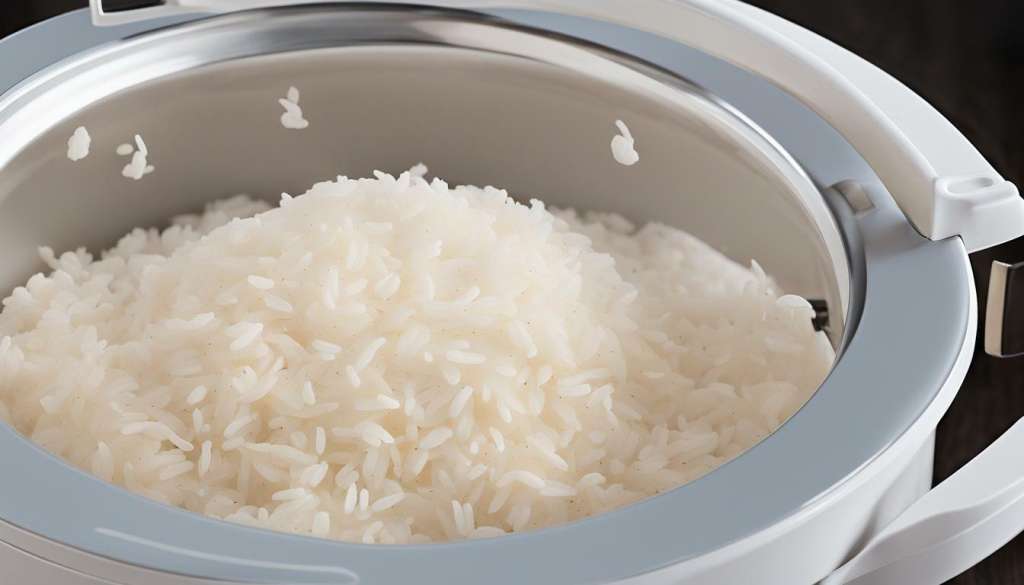
Rice Cooker Rice Preservation
Preserving the quality and safety of rice stored in a rice cooker is critical for ensuring delicious and nutritious meals. Proper rice cooker rice preservation practices can help maintain the freshness, taste, and texture of rice, providing a satisfying dining experience every time. Here are some essential tips to help you preserve rice in your rice cooker:
Keep the Rice Cooker Clean
Regular cleaning of the rice cooker is crucial for preventing the growth of harmful bacteria and maintaining food safety. Make sure to clean the rice cooker thoroughly after each use, including the lid, inner pot, and steam vent. Use warm soapy water and a soft sponge to wipe away any food residue and rinse it well to remove any traces of detergent. Avoid using abrasive cleaners or harsh chemicals that can damage the rice cooker’s surface or leave behind residues that can contaminate the rice.
Store Rice at the Right Temperature
The temperature at which you store rice in a rice cooker is essential for preserving its quality and safety. Rice should be kept at a temperature between 40°F and 140°F to prevent bacterial growth. If you’re unsure about the temperature, use a food thermometer to measure the temperature of the rice. If the temperature is outside the safe range, reheat the rice to above 165°F before storing it again.
Avoid Excessive Moisture
Excessive moisture can cause rice to become mushy and spoil quickly. Make sure to remove any excess water from the rice before storing it in the rice cooker. Use a fork to fluff the rice and allow it to cool down before storing it to prevent moisture buildup. If possible, keep the rice cooker in a dry place to minimize humidity and moisture exposure.
Optimize Storage Time
Storing rice in a rice cooker for too long can affect its quality and safety. The ideal time to keep rice in a rice cooker varies depending on factors such as rice type, temperature, and humidity. As a general rule, it is best to consume rice within 24 hours of cooking and storage. If you need to store rice for more extended periods, transfer it to an airtight container and refrigerate it within two hours of cooking.
Reheat Rice Properly
Reheating rice is an essential step in ensuring safe consumption. Make sure to reheat rice thoroughly before eating, bringing it to a temperature of at least 165°F to kill any bacteria that may have formed during storage. Avoid reheating rice more than once, as this can cause bacterial growth and spoilage.
By following these guidelines for rice cooker rice preservation, you can ensure that your stored rice stays fresh, safe, and tasty.
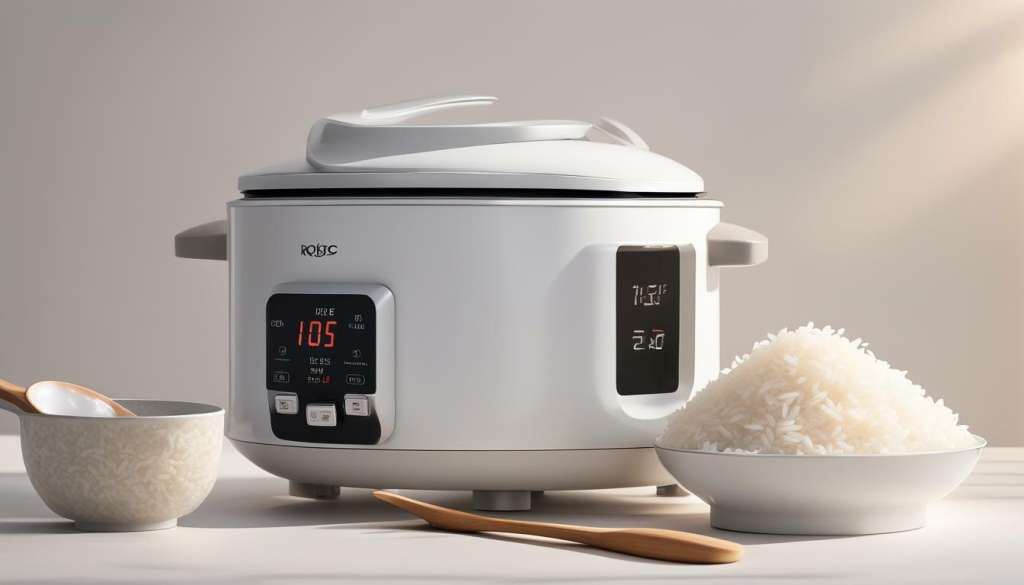
Storing Leftover Rice in a Rice Cooker
Leftover rice is a convenient and tasty option for quick meals, but it’s important to store it properly to avoid foodborne illnesses. Fortunately, a rice cooker can serve as a convenient storage solution for leftover rice.
When storing leftover rice in a rice cooker, it’s important to follow proper portioning and cooling methods to prevent bacterial growth. First, transfer any leftover rice to the rice cooker as soon as possible after the meal has finished. Use a spoon or spatula to break up any clumps of rice and ensure even cooling.
Once the leftover rice has cooled to room temperature, close the lid of the rice cooker and store it in the refrigerator. Make sure the rice cooker is clean and free from any contaminants before storing the rice.
When reheating leftover rice from the rice cooker, make sure it reaches a temperature of at least 165°F to kill any harmful bacteria. Use a microwave or stovetop to reheat the rice. Always discard any leftover rice that has been left at room temperature for more than two hours to avoid the risk of foodborne illnesses.
By following these tips, you can safely store and enjoy leftover rice in your rice cooker without any worries about food safety.

Cleaning and Maintenance of Rice Cookers
Regular cleaning and maintenance of your rice cooker are essential for ensuring its longevity and maintaining food safety. Dirty rice cookers may harbor harmful bacteria, which can lead to foodborne illnesses. Here are some tips for keeping your rice cooker clean:
- Always unplug the rice cooker and allow it to cool down before cleaning.
- Wipe down the exterior of the rice cooker with a damp cloth and mild soap.
- Remove the inner pot and wash it with warm, soapy water. Rinse it thoroughly and dry it before placing it back in the rice cooker.
- Regularly clean the steam vent to prevent clogs and ensure proper ventilation.
- Use vinegar and water to remove tough stains or residue buildup in the inner pot.
Proper maintenance of your rice cooker can also help ensure its longevity. Here are some additional tips:
- Follow the manufacturer’s instructions for use and care.
- Replace any damaged or worn-out parts promptly.
- Store your rice cooker in a cool, dry place when not in use.
- Avoid exposing your rice cooker to extreme temperatures or moisture.
Regular cleaning and maintenance of your rice cooker not only helps to maintain its longevity but also ensures food safety. By following these simple tips, you can enjoy delicious and safe rice for longer durations.
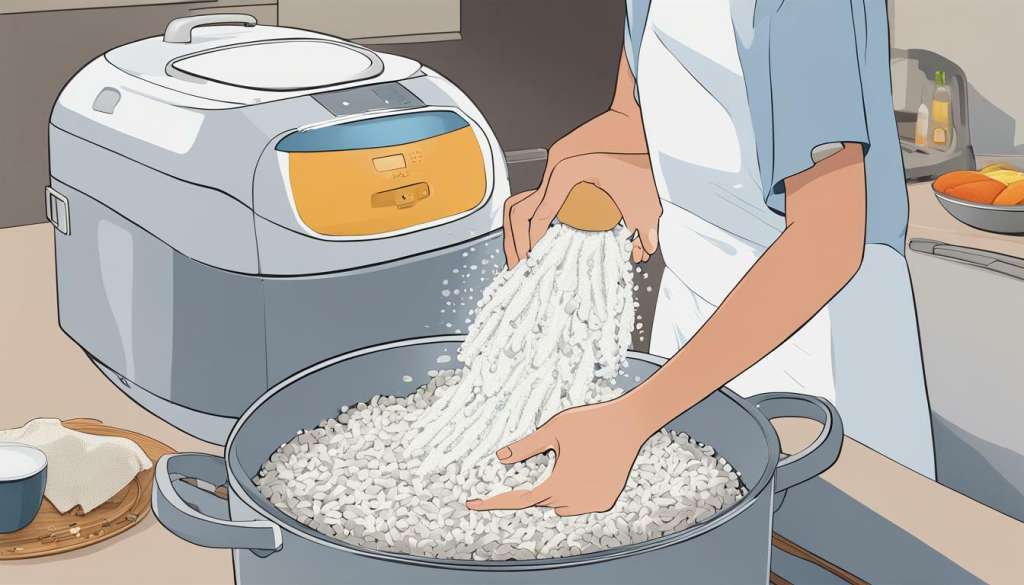
Significance of Proper Rice Storage
Proper rice storage in a rice cooker is crucial for maintaining the freshness and quality of the rice. However, it is also essential for ensuring food safety. Improper storage can lead to bacterial growth, causing foodborne illnesses. Therefore, it is important to follow the guidelines for storing rice in a rice cooker to minimize the risk of contamination.
The significance of proper rice storage cannot be overstated. Fresh and high-quality rice enhances the taste and overall experience of any dish, while also providing essential nutrients. On the other hand, rice that has been stored improperly can have a stale taste, a dry or sticky texture, or even contain harmful bacteria that can cause illness.
By storing rice properly in a rice cooker, you can not only extend its shelf life but also ensure that it remains safe to consume. It is important to follow the guidelines for storing, reheating, and consuming rice to minimize the risk of food poisoning. Safe and proper rice storage in a rice cooker is a necessary step towards preparing delicious and healthy meals for you and your family.
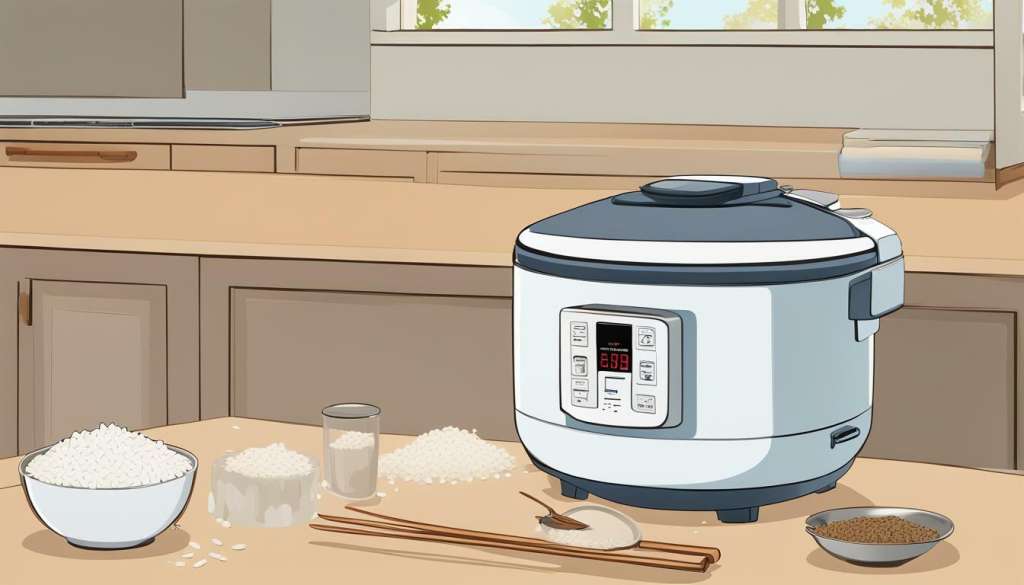
Tips for Keeping Rice Fresh in a Rice Cooker
Proper storage is crucial for maintaining the freshness and taste of rice in a rice cooker. Here are some tips to help you keep your rice fresh:
- Portion control: Only cook the amount of rice you need for the meal to avoid excess rice sitting in the cooker for long periods.
- Keep rice at the right temperature: After cooking, switch the cooker to “keep warm” mode to prevent the rice from drying out or becoming soggy. However, avoid leaving rice in the cooker for more than 12 hours.
- Avoid excessive moisture: Keep the cooker lid open after cooking to prevent moisture buildup that may cause spoilage or mold growth.
- Prevent rice from becoming dry or sticky: Store rice in an airtight container to keep moisture at a consistent level. You can add a few drops of water when reheating to prevent the rice from being too dry.
- Clean the cooker regularly: Proper maintenance and cleaning of the cooker can prevent bacterial growth and keep the rice fresh for longer periods.
Following these tips will help you maximize the lifespan of your rice in the cooker and ensure you have fresh, delicious rice every time.

Storing Different Types of Rice in a Rice Cooker
Storing different types of rice in a rice cooker requires consideration of their unique properties. Different rice varieties have varying cooking times, moisture content, and texture, which can affect their storage duration.
Firstly, short-grain rice, such as sushi rice, tends to be stickier and moister than long-grain rice. It is essential to use the correct water to rice ratio for each variety to ensure proper cooking and storage.
| Rice Variety | Water to Rice Ratio |
|---|---|
| Short-Grain Rice | 1:1.25 |
| Long-Grain Rice | 1:1.5 |
Secondly, brown rice has a higher oil content than white rice, making it more susceptible to rancidity and spoilage. It is best to store brown rice in airtight containers in a cool, dry place to extend its shelf life.
Lastly, wild rice and other exotic rice varieties require specific cooking and storage methods. It is necessary to follow the cooking instructions on the package carefully and store them in separate containers to avoid cross-contamination.
By taking into account the unique properties of each rice variety, you can optimize their storage duration and maintain their quality in the rice cooker.

Safe Consumption of Rice Stored in a Rice Cooker
When it comes to consuming rice stored in a rice cooker, safety is crucial. Prolonged storage or improper reheating can lead to bacterial contamination, resulting in foodborne illnesses. Follow these tips to ensure safe consumption of rice stored in a rice cooker:
- Reheat rice thoroughly: When reheating rice, make sure it reaches an internal temperature of 165°F to kill any bacteria. Use a food thermometer to check the temperature.
- Do not leave rice in the rice cooker for too long: Rice should not be left in the rice cooker for more than a day. If you’re not planning to consume the rice within this timeframe, transfer it to a different container and refrigerate it.
- Store rice at the right temperature: Rice should be stored at or below 40°F to prevent bacterial growth. If you’re using the “keep warm” function of the rice cooker, make sure it doesn’t stay on for too long and keeps the temperature under 140°F.
- Discard any leftover rice: If you have rice leftover after reheating, it’s best to discard it. Reheated rice should not be stored for more than a day as it increases the risk of bacterial growth and foodborne illnesses.
By following these guidelines, you can enjoy delicious and safe rice stored in a rice cooker.
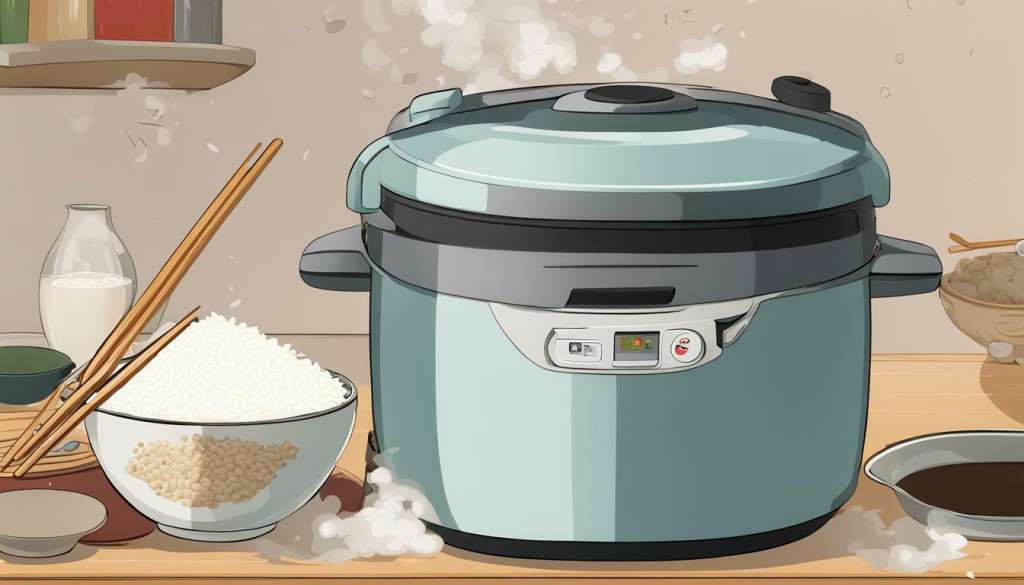
Conclusion
Proper storage of rice in a rice cooker is essential for maintaining freshness and ensuring food safety. Following the guidelines provided in this article will help to prevent spoilage and bacterial growth, and extend the storage duration of your rice. Remember to keep your rice cooker clean and free from contaminants, and to store different types of rice according to their unique qualities.
Additionally, proper portioning and reheating practices are crucial for safe consumption of leftover rice. Take the necessary steps to cool and store leftover rice quickly, and reheat it to the appropriate temperature to minimize the risk of bacterial contamination.
Regular cleaning and maintenance of your rice cooker is also important for both rice storage and the longevity of your appliance. Follow the manufacturer’s instructions for cleaning and maintenance to keep your rice cooker in top condition.
Enjoy Delicious and Safe Rice for Longer Durations
By following the tips and guidelines provided in this article, you can enjoy delicious and safe rice for longer durations. Remember to monitor the storage duration of your rice, and to take steps to optimize storage conditions based on the specific type of rice you are storing. With proper rice storage in a rice cooker, you can ensure that your rice stays fresh and tasty for all your meals.
FAQ
Q: How long can rice stay in a rice cooker?
A: Rice can typically stay in a rice cooker for up to 12-24 hours. It is important to properly store the rice to maintain freshness and ensure food safety.
Q: How do I preserve rice in a rice cooker?
A: To preserve rice in a rice cooker, make sure to keep the cooker clean and free from contaminants. Store the rice in an airtight container within the rice cooker to prevent spoilage and maintain food safety.
Q: What is the maximum duration for rice in a rice cooker?
A: The maximum duration for rice in a rice cooker depends on factors such as rice type, temperature, and humidity. It is recommended to consume the rice within 12-24 hours to ensure the best quality.
Q: Can rice storage be extended in a rice cooker?
A: It is possible to extend rice storage duration in a rice cooker by using the keep warm function or transferring the rice to a different container. However, it is important to follow safe storage practices to maintain rice quality during extended storage.
Q: How can I preserve rice in a rice cooker?
A: To preserve rice in a rice cooker, optimize rice quality and prevent spoilage by properly portioning and reheating the rice. This helps maintain the freshness and taste of the rice.
Q: Can I store leftover rice in a rice cooker?
A: Yes, leftover rice can be stored in a rice cooker. Proper portioning and cooling methods should be followed to store leftover rice safely and prevent foodborne illnesses.
Q: How do I clean and maintain a rice cooker?
A: Regular cleaning and maintenance of a rice cooker are important for its longevity and the quality of rice storage. Follow step-by-step instructions, ensuring cleanliness to maintain food safety.
Q: Why is proper rice storage significant?
A: Proper rice storage is significant as improper storage can lead to bacterial growth and foodborne illnesses. Maintaining rice freshness and quality through correct storage practices is crucial.
Q: What are some tips for keeping rice fresh in a rice cooker?
A: To keep rice fresh in a rice cooker, practice portion control, store rice at the right temperature, and avoid excessive moisture. This helps prevent rice from becoming dry or sticky during storage.
Q: How should different types of rice be stored in a rice cooker?
A: Different types of rice may require different storage considerations in a rice cooker. Factors such as cooking time, moisture content, and texture can vary between varieties. Follow guidelines specific to each type of rice to maintain its unique qualities.
Q: Is it safe to consume rice stored in a rice cooker?
A: Safety concerns regarding consuming rice stored in a rice cooker are addressable. Prolonged storage and improper reheating can pose risks. Reheating rice properly minimizes the risk of bacterial contamination and ensures safe consumption.


